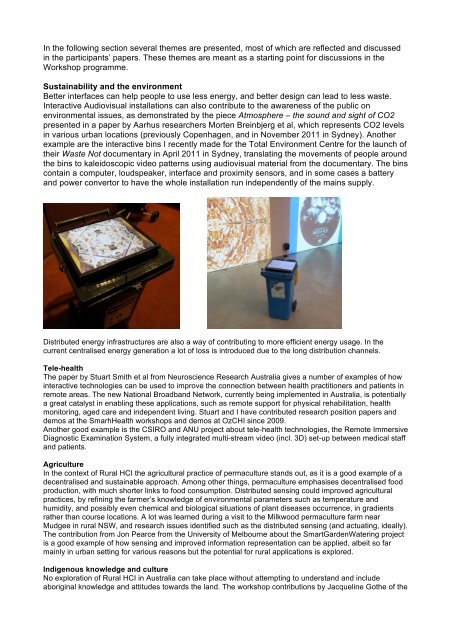Rural HCI - Bert Bongers - Xs4all
Rural HCI - Bert Bongers - Xs4all
Rural HCI - Bert Bongers - Xs4all
Create successful ePaper yourself
Turn your PDF publications into a flip-book with our unique Google optimized e-Paper software.
In the following section several themes are presented, most of which are reflected and discussedin the participants’ papers. These themes are meant as a starting point for discussions in theWorkshop programme.Sustainability and the environmentBetter interfaces can help people to use less energy, and better design can lead to less waste.Interactive Audiovisual installations can also contribute to the awareness of the public onenvironmental issues, as demonstrated by the piece Atmosphere – the sound and sight of CO2presented in a paper by Aarhus researchers Morten Breinbjerg et al, which represents CO2 levelsin various urban locations (previously Copenhagen, and in November 2011 in Sydney). Anotherexample are the interactive bins I recently made for the Total Environment Centre for the launch oftheir Waste Not documentary in April 2011 in Sydney, translating the movements of people aroundthe bins to kaleidoscopic video patterns using audiovisual material from the documentary. The binscontain a computer, loudspeaker, interface and proximity sensors, and in some cases a batteryand power convertor to have the whole installation run independently of the mains supply.Distributed energy infrastructures are also a way of contributing to more efficient energy usage. In thecurrent centralised energy generation a lot of loss is introduced due to the long distribution channels.Tele-healthThe paper by Stuart Smith et al from Neuroscience Research Australia gives a number of examples of howinteractive technologies can be used to improve the connection between health practitioners and patients inremote areas. The new National Broadband Network, currently being implemented in Australia, is potentiallya great catalyst in enabling these applications, such as remote support for physical rehabilitation, healthmonitoring, aged care and independent living. Stuart and I have contributed research position papers anddemos at the SmarhHealth workshops and demos at OzCHI since 2009.Another good example is the CSIRO and ANU project about tele-health technologies, the Remote ImmersiveDiagnostic Examination System, a fully integrated multi-stream video (incl. 3D) set-up between medical staffand patients.AgricultureIn the context of <strong>Rural</strong> <strong>HCI</strong> the agricultural practice of permaculture stands out, as it is a good example of adecentralised and sustainable approach. Among other things, permaculture emphasises decentralised foodproduction, with much shorter links to food consumption. Distributed sensing could improved agriculturalpractices, by refining the farmer’s knowledge of environmental parameters such as temperature andhumidity, and possibly even chemical and biological situations of plant diseases occurrence, in gradientsrather than course locations. A lot was learned during a visit to the Milkwood permaculture farm nearMudgee in rural NSW, and research issues identified such as the distributed sensing (and actuating, ideally).The contribution from Jon Pearce from the University of Melbourne about the SmartGardenWatering projectis a good example of how sensing and improved information representation can be applied, albeit so farmainly in urban setting for various reasons but the potential for rural applications is explored.Indigenous knowledge and cultureNo exploration of <strong>Rural</strong> <strong>HCI</strong> in Australia can take place without attempting to understand and includeaboriginal knowledge and attitudes towards the land. The workshop contributions by Jacqueline Gothe of the


